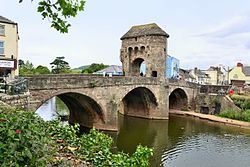
Back جسر مونو Arabic Monnow Bridge Catalan Most přes Monnow Czech Pont Trefynwy Welsh Monnow Bridge Danish Monnow Bridge German Ponto Monnow Esperanto Monnow zubia Basque Monnow Brúgvin Faeroese Pont Monnow French
Monnow Bridge Pont Trefynwy Bridge in Wales | |
|---|---|
 View of the bridge looking north | |
| Coordinates | 51°48′32″N 2°43′12″W / 51.8090°N 2.7200°W |
| Carries | Pedestrian traffic |
| Crosses | River Monnow |
| Locale | Monmouth, Monmouthshire, Wales |
| Characteristics | |
| Design | Bridge tower |
| Material | Old Red Sandstone |
| Total length | 34.80 m (114.2 ft) |
| Width | 7.30 m (24.0 ft) |
| No. of spans | 3 |
| Piers in water | 2 |
| History | |
| Construction start | c. 1272 |
Listed Building – Grade I | |
| Official name | Monnow Bridge and Gateway |
| Designated | 15 August 1974 |
| Reference no. | 2218 |
| Official name | Monnow Bridge |
| Designated | 24 July 1974 |
| Reference no. | MM008 |
| Location | |
 | |
Monnow Bridge (Welsh: Pont Trefynwy Welsh pronunciation: [pɔnt tre:vənʊɨ]), in Monmouth, Wales, is the only remaining fortified river bridge in Great Britain with its gate tower standing on the bridge. Such bridge towers were common across Europe from medieval times, but many were destroyed due to urban expansion, diminishing defensive requirements and the increasing demands of traffic and trade. The historical and architectural importance of the bridge and its rarity are reflected in its status as a scheduled monument and a Grade I listed building. The bridge crosses the River Monnow (Afon Mynwy) 500 metres (1,600 ft) above its confluence with the River Wye.
Monmouth had been a significant border settlement since the Roman occupation of Britain, when it was the site of the fort of Blestium. The River Wye may have been bridged at this time but the Monnow, being easily fordable, appears not to have had a crossing until after the Norman Conquest. According to the local tradition, construction of Monnow Bridge began in 1272 to replace a 12th-century Norman timber bridge. Through the medieval era, the English Civil War, and the Chartist uprising, the bridge played a significant, if ineffectual, role in defending Monmouth. It also served as a gaol, a munitions store, a lodge, an advertising hoarding, a focus for celebrations and, most significantly, as a toll gate. Much of the medieval development of Monmouth was funded by the taxes and tolls the borough was entitled to raise through royal charter. The tolls were collected through control of the points of entry to the town, including the gatehouse on Monnow Bridge.
Built predominantly of Old Red Sandstone, the bridge was the subject of significant reconstruction and rebuilding in the 18th and 19th centuries. In those centuries, it also became a popular subject for artists; Turner, Gastineau and Cotman produced sketches of the bridge and gate. In the 20th century, it suffered increasing damage as higher volumes of traffic and the use of ever-larger vehicles led to several serious accidents. In the 21st century, the construction of a new road crossing to the south enabled the pedestrianisation of the bridge.